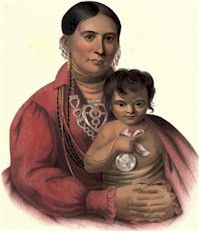The Osage Massacre
When the treaty council with the Osage at Fort Gibson broke up in disagreement on April 2, 1833, three hundred Osage warriors under the leadership of Clermont departed for the west to attack the Kiowa. It was Clermont’s boast that he never made war on the whites and never made peace with his Indian enemies. At the Salt Plains where the Indians obtained their salt, within what is now Woodward County, Oklahoma, they fell upon the trail of a large party of Kiowa warriors going northeast toward the Osage towns above Clermont’s. The Osage immediately adapted their course to that pursued by their enemies following it back to what they knew would be the defenseless village of women, children, and old men left behind by the warriors. The objects of their cruel vengeance were camped at the mouth of Rainy-Mountain Creek, a southern tributary of the Washita, within the present limits of the reservation at Fort Sill.


